
Matt Hampel is a socially and environmentally conscious digital native who can work from anywhere with a laptop and smart phone. He’s a graduate of an elite Michigan university and has zero desire to own a car.
At age 25, he’s co-founder of LocalData, which seeks to make the access and dissemination of municipal data possible through technology and custom apps, and Code for Detroit, a local offshoot of Code for America.
“I don’t drive a car for a couple of reasons,” he says. “One is cost – I don’t want the burden of insurance, maintenance, gas or the up-front purchase.
“I also like making conscious decisions about transportation – not just jumping in the car. I’ve always lived in places where I’m lucky enough to be able to bike, walk or take public transit where I want to go.”
Avoiding cars is possible in cities like Ann Arbor and San Francisco. But he lives in Detroit.
Thankfully, Detroit’s wide, essentially carless streets offer him the space and safety he needs to ride his bike wherever he wants to go on a daily basis. He’s able to bring his bike into his office for safekeeping, and if needed, he can put his bike on the bus rack if he’s taking a long-haul trip to the suburbs.
But that’s not the case for most cities in Michigan. And frankly, as a millennial who values convenience, being connected to his community and maintaining a healthy work/life balance, for now, Hampel won’t be looking for a job with an organization that can’t accommodate that he’s carless.
“I probably won’t take a job somewhere I can only get to by car,” he says. “Most places like that seem like a bad fit. It signals isolation and an unwillingness to engage in the community around you.”
Recent research has shown that vehicle miles traveled is declining the fastest among 16- to 34-year-olds. Peak automobile ownership nationwide appears to have been reached in 2007 and there is no rebound in sight.
Folks in this generation – the millennials – are more likely to want to live in urban and walkable neighborhoods and they want non-driving forms of transportation, more than any other generation of Americans before them.
So just how are cities and businesses adjusting to the changing expectations of the workforce – or are they?
Grand Rapids area
Grand Rapids is making great strides in creating an economic development atmosphere that supports the implementation, adoption and use of multimodal transportation – for developers, employers and employees.
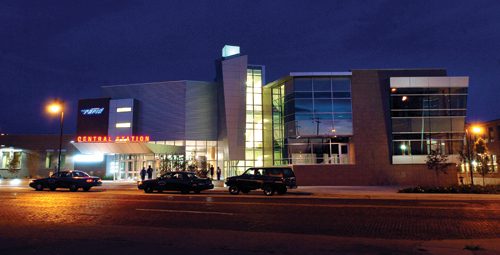
They’ve had a 44 percent increase in transit ridership in the last five years with a goal of a 10 percent modal shift away from the car by the end of 2015. This goal happens to coincide with the planned opening of the state’s first bus rapid transit line in August along Division Avenue.
According to Suzanne Schultz, Grand Rapids’ managing director of design, development and engagement, ridership has been so successful along TheRapid’s Laker Line (a bus line that runs to and from Grand Valley State University) that GVSU is planning to get rid of some of its parking lots.
TheRapid has partnered with GVSU and for all their employees and students, transit is free,” she says. “That’s a $2 million subsidy. Because of the success of the line, businesses are looking to coordinate the bus rapid transit around [the Laker Line] now, too.
“The demand for parking has decreased so much that [GVSU] doesn’t have to provide parking – they’re looking at those parking lots as future development sites and employees are looking to relocate closer to those bus lines.”

Grand Rapids has also updated its zoning laws to remove out of date parking minimums and now requires that bike parking and sidewalks be installed when businesses renovate or fall under new owners or new use.
Atomic Object, a software development firm with offices in Grand Rapids, Ann Arbor and Detroit, purchased its Grand Rapids headquarters building in 2003. Their initial approach to renovations did not include accommodating bicycle commuters. But when renovations began, employees started to voice some interesting requests.
“Employees came to us to say you know, ‘we’re renovating this building and many of us live nearby and we’d like to bike and walk to work, and we’d also like to do it in the winter,’” says Mary O’Neill, business manager at Atomic Object. “So all of a sudden, we had people asking for some help but offering some creative ideas for how to store bikes on the inside in inclement weather.”
Instead of gutting and installing a traditional bathroom, they restored an old bathroom that already had a shower so those who rode to work in the summer would have a place to clean up before their workday begins.
They also saved on parking costs by decreasing the number of car parking spaces they needed to build and maintain in their lot.
“We didn’t just assume people were going to come to work one car one person,” O’Neill says. “We own our building but we only need a few parking spaces and otherwise we have shared parking spaces around our building.”
Since Grand Rapids no longer has parking minimum requirements, Atomic Object was able to save a great deal of money while accommodating their employee’s needs.
On average, the cost to build one car parking space in the U.S. is more than $16,000, but it costs between $100 and $400 to install an on-sidewalk bike rack that holds two bikes. Atomic Object has parking for six to 10 bikes out front and another six secure spots inside, all of which are routinely full. That’s the equivalent of removing 16 parking spots for single-car commuters – you do the math.
O’Neill recommends businesses take a hard look at the cost of installing and/or paying for employee car parking when they start to do a cost benefit analysis for accommodating bicyclists’ infrastructure requests.
For a small business just beginning to look at how to accommodate non-car commuters, she says not to assume it’s too expensive.
“Just allowing employees to bring bikes into the office – especially when no bike racks exist outside – is one way to let employees know you’re a bike friendly business,” she says.
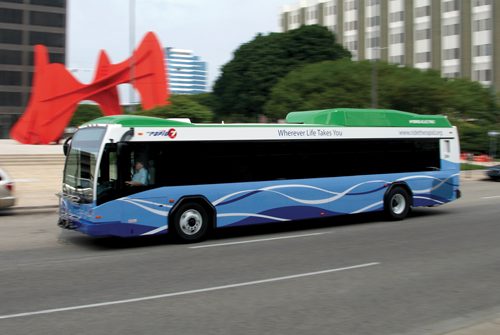
Finding out what your city’s ordinances are regarding bike racks is another. Some municipalities allow you to install racks on private property – which gives the property owner some control of bike rack design, while others may allow you to request they be installed at no cost to you.
Nearly 30 percent of Atomic Object’s Grand Rapids workforce now bikes, walks or takes the bus to work. They’ve not only realized financial benefits, but staff are happier and healthier, and their approach allows them to attract folks that fit right in with their corporate culture.
“In Grand Rapids, regardless of age, we find people who are interested in exploring a non-car oriented life, one where at least if they wanted to, they have the opportunity to get to work by some other means,” O’Neil says.
“We want to attract people to our company who are both passionate about our work – software developers and designers – and who are interested in their community – in living and working within their community. So we find people who are like, ‘Wow, you guys aren’t in an anonymous suburb in a boring old building I can only get to by car.’”
Ann Arbor
In Ann Arbor, where getDowntown has been blazing the multimodal transportation trail since the late 1990s, a recent survey showed just how much employers in downtown value the variety of transportation alternatives available.
More than 80 percent of respondents said a variety of transportation options is important for attracting customers or clients and a high quality workforce.
getDowntown provides commuting programs and services to employers and employees from unlimited-use bus go!passes and bike locker rentals, to events like the Commuter Challenge and Conquer the Cold, and more.
The variety of transit options available in Ann Arbor ultimately translates into more options and better work/life balance for many Ann Arborites.
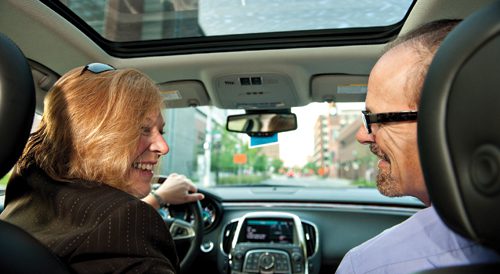
“Because of Zipcars and the bikeshare program, it is becoming much easier for someone who lives close to the downtown area to consider giving up their car or becoming a one-car family,” says Nancy Shore, getDowntown Program director. “… As people move closer to their work, it frees up more time that is typically lost in a commute. That can only help enhance a person’s work/life balance by giving them more time to run errands, hang out with friends, etc.”
The survey also showed how employees who live four miles or less from work choose to bike, walk or bus rather than ride in cars alone. This is particularly true for students in the area.

Shore recommends if employers have a commuter services program in their area like the getDowntown Program to reach out to and see what they offer. Like getDowntown, many of these programs can help craft packages that are attractive to your employees, provide education, and customize brochures to include in your recruitment and orientation materials.
“It would also be great for a business owner to check in with their staff to see how they are currently getting to work and if they are satisfied with that option,” Shore says. “We are surprised sometimes that a business owner is unaware that most of their employees bus to work, or that many employees drive but are really not happy about that.
“Knowing what your employees are currently doing and what they would like to do could help you provide them with some resources to make them happier, more productive employees.”
Traverse City area
In the four-season tourist town of Traverse City, facilitating alternative transportation has less to do with accommodating the needs of employees than dealing with the congestion and parking shortages brought on by its booming tourism industry.
“As Traverse City grows and as congestion increases, we must make the decision either to widen our roads to accommodate more traffic, or help people get around with bikes and buses, and reduce traffic for our neighbors,” Jim Bruckbauer, transportation policy specialist at the Michigan Land Use Institute told Bridge Magazine.
And for the primarily rural region, 80 percent of area residents don’t really see alternative transportation as an option, according to a survey conducted last year.
To help deal with their unique challenges, the six counties surrounding Traverse City have embarked on a mammoth effort to improve mobility throughout the region.
Luckily for businesses and employees, public transit and programs are available to vacationers and employees alike. These include a Smart Commute program which encourages individuals to use the Traverse Area Regional Transportation Trail system, a network of 60 miles of trails throughout the area, to get around by bike.
Their local bus service, Bay Area Transit Authority, has recently implemented a Bike-n-Ride program, which allows for 11 bikes to be transported on certain routes near trails July 1 through Sept. 1. Area businesses are beginning to experiment with park-n-ride and carpooling services. The city also has plenty of bike parking – 125 bike racks and 13 bike lockers so far.
Lansing
As has been the case with many post-industrial cities, the economic downturn and decline of the car industry took a particular toll on cities like Detroit and Lansing. Commercial centers declined, housing stock deteriorated, and populations continue to age. Unemployment in Lansing reached 10 percent in 2008.
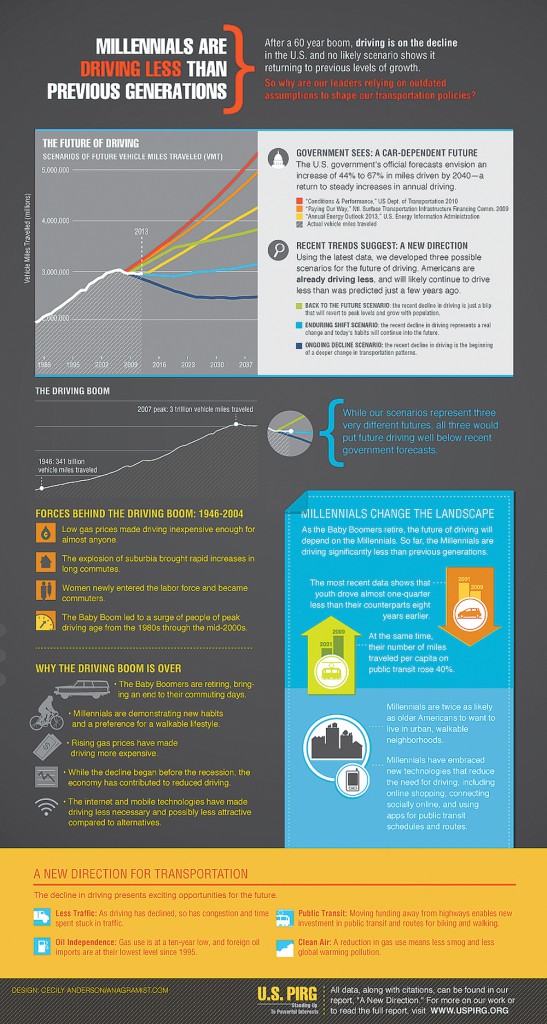 A strategic plan adopted in 2011 called Design Lansing specifically acknowledges the need to attract younger talent to the region in order to grow and diversify its economy.
A strategic plan adopted in 2011 called Design Lansing specifically acknowledges the need to attract younger talent to the region in order to grow and diversify its economy.
The well-educated, creative professionals and entrepreneurs who drive the creation and growth of new economy businesses are not tied to a particular place by the need to be close to raw materials or built infrastructure. As a result, they can choose to locate anywhere. Research has shown that these knowledge workers are looking for the following characteristics in the places they choose to live:
• Vibrant and attractive urban environments that provide access to everyday needs by walking or using transit.
• Diverse, racially-integrated communities.
• A rich mix of retail, entertainment and cultural offerings.
• Ready access to outdoor activities that support an active lifestyle.
• Third place social environments (parks, cafes and bookstores).
Part of the plan envisions developing more than 740 miles of bike lanes by 2020 and “encouraging walkable, mixed-use, transit-supportive development along major gateway streets; implementing its recently adopted Non-Motorized Plan; and working to create a linked system of open spaces (green infrastructure) as part of a regional network for recreation and environmental protection.”
But Joe Fedewa, options coordinator for Clean Commute, offers plenty of things businesses can be doing to support the alternative transportation needs of employees now, such as ride-sharing, participating in commuter challenges and more.
“Businesses that participate experience an increase in the timeliness of their employees,” he says. “And employees experience longevity and other health benefits. We have one commuter who has been riding for more than a decade. He’s approaching his 1 millionth commuter mile.”
Though Clean Commute started in 2006 primarily to build public awareness of air quality issues and reduce traffic congestion, it’s grown into a comprehensive commuter support program for Lansing-area employers.
John Lindenmeyer, advocacy and policy director for the League of Michigan Bicyclists shares some significant health benefits for employees – and employers – that support bike commuting.
… promoting biking is an investment [for businesses], and increased productivity will offset infrastructure costs the employer may incur.
Benefits mentioned include:
• Exercising before work raises an employee’s productivity by an average of 15 percent.
• Cyclists take 15 percent fewer days off work due to illness.
• Statistics show non-cyclists take two more sick days per year.
• Studies show 27 percent fewer task errors for physically fit employees.
In addition to health benefits, employers and employees can claim a tax benefit each year; up to $250, depending on the mode of transportation used.
Detroit
Though Hampel manages to get around Detroit with a bike, more than 30 percent of the city’s residents don’t have access to a car, and it’s no secret that Detroit’s’ transit system is unreliable at best.
Businesses like Quicken Loans are taking matters into their own hands to help meet the alternative transportation needs of their employees by providing shuttles, bike parking, vanpools and more.
Michelle Salvatore, director of recruiting for Quicken Loans has a smorgasbord of transit choices for current and prospective employees.
“Our Millennial workforce loves to work in a downtown urban core. If somebody lives in the urban core and they want to ride their bike to work, we have a rack in one of our garages. We also have partnered with Zagster which provides 62 bikes throughout the downtown.”
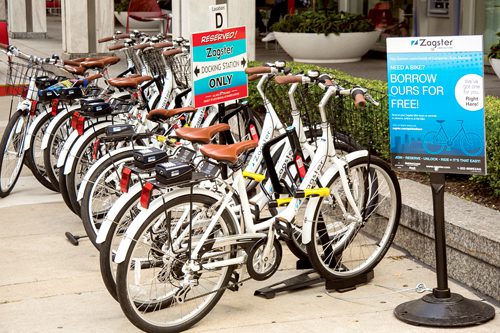
Since it launched in June last year, more than 2,000 team members have used the Zagster service courtesy of Quicken Loans and the Rock family of companies, resulting in more than 7,000 rides.
“It’s great for people who may or may not commute to work via car,” she says. “You can jump on a bike with three or four of your co-workers, ride it to the RenCen for lunch and back without having to deal with parking.”
Best of all, if you live and work downtown, as a Quicken employee, you can access the bikes 24/7 and check a bike out for up to 24 hours for free.
Quicken employees also have access to a shuttle bus to and from Troy that leaves three times per day from both locations, a vanpool service, discount SMART bus passes and Zipcars.
“Employees [who don’t use parking] also get an opt-out parking incentive – almost a bonus they get monthly,” Salvatore says. “It does make a difference across the board, the folks coming in from Troy, if traffic is bad, you’re tired by the time you get to work or stressed out. We know our folks come to work pretty relaxed.”
Projected to begin service in 2015, the M-1 Rail will add to the mobility mix in Detroit. The 3.3-mile circulating streetcar will run along Woodward between Larned downtown and West Grand Boulevard in New Center. A fair amount of controversy has swirled around the design of the line and just who it will serve, but for Quicken Loans/Rock Ventures commuters who use shuttle buses to get downtown from their commuter parking in New Center, and those living near Wayne State University, it’s certainly going to help move people in those areas to and from downtown.
Residents who live and work in the greater Downtown area — especially those who have night lives — will have curb-side access to businesses and entertainment along Woodward. Businesses seeking to open up shop in greater downtown, and real estate developers, find it and especially attractive selling point.








